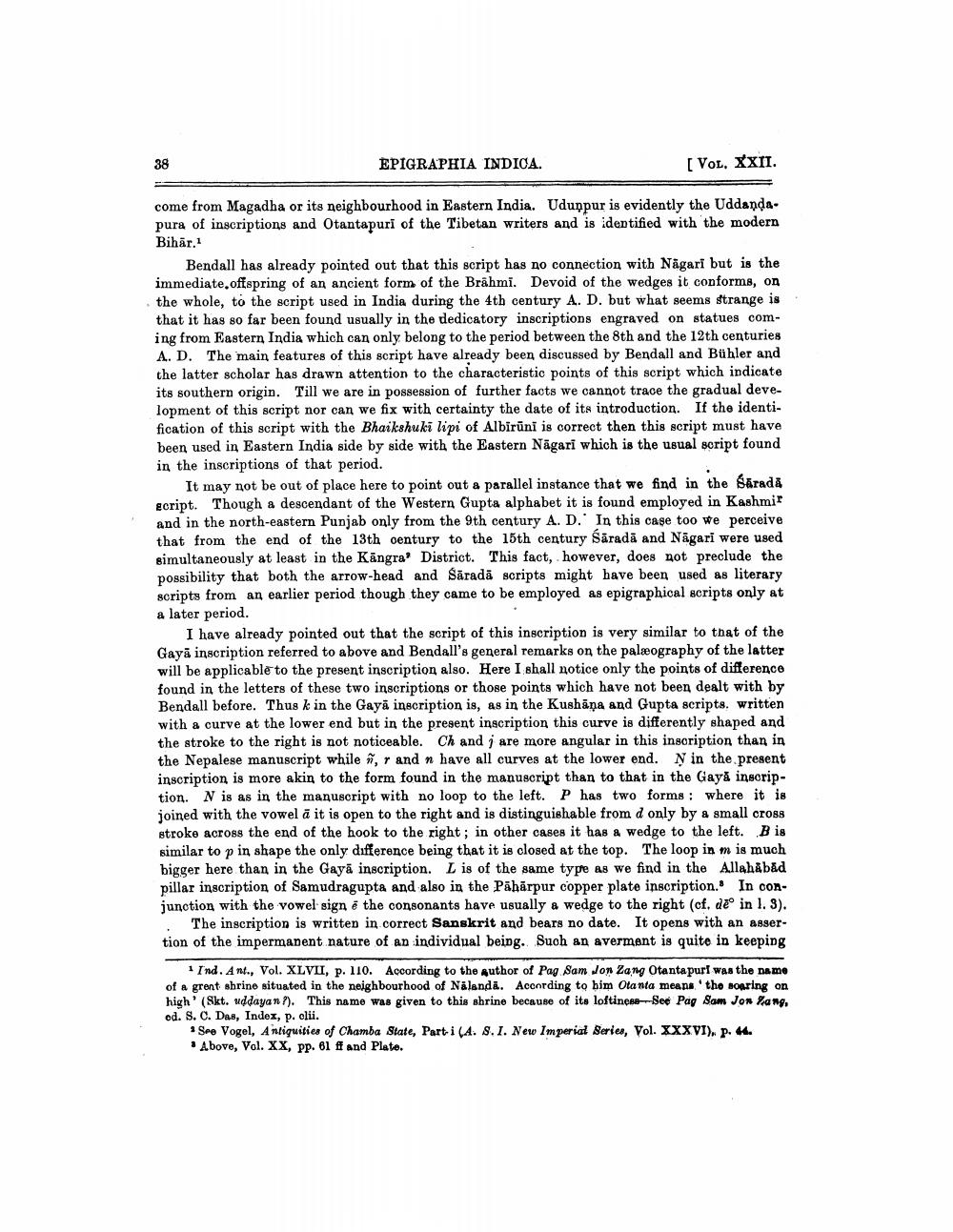________________
38
EPIGRAPHIA INDICA.
[VOL. XXII.
come from Magadha or its neighbourhood in Eastern India. Udunpur is evidently the Uddandapura of inscriptions and Otantapuri of the Tibetan writers and is identified with the modern Bihar.1
Bendall has already pointed out that this script has no connection with Nagari but is the immediate, offspring of an ancient form of the Brahmi. Devoid of the wedges it conforms, on the whole, to the script used in India during the 4th century A. D. but what seems strange is that it has so far been found usually in the dedicatory inscriptions engraved on statues coming from Eastern India which can only belong to the period between the 8th and the 12th centuries A. D. The main features of this script have already been discussed by Bendall and Bühler and the latter scholar has drawn attention to the characteristic points of this script which indicate its southern origin. Till we are in possession of further facts we cannot trace the gradual development of this script nor can we fix with certainty the date of its introduction. If the identification of this script with the Bhaikshuki lipi of Albirūni is correct then this script must have been used in Eastern India side by side with the Eastern Nagari which is the usual script found in the inscriptions of that period.
It may not be out of place here to point out a parallel instance that we find in the Saradă script. Though a descendant of the Western Gupta alphabet it is found employed in Kashmir and in the north-eastern Punjab only from the 9th century A. D. In this case too we perceive that from the end of the 13th century to the 15th century Sarada and Nagari were used simultaneously at least in the Kangra District. This fact, however, does not preclude the possibility that both the arrow-head and Sarada scripts might have been used as literary scripts from an earlier period though they came to be employed as epigraphical scripts only at a later period.
I have already pointed out that the script of this inscription is very similar to that of the Gaya inscription referred to above and Bendall's general remarks on the palæography of the latter will be applicable to the present inscription also. Here I shall notice only the points of difference found in the letters of these two inscriptions or those points which have not been dealt with by Bendall before. Thus k in the Gaya inscription is, as in the Kushana and Gupta scripts. written with a curve at the lower end but in the present inscription this curve is differently shaped and the stroke to the right is not noticeable. Ch and j are more angular in this inscription than in the Nepalese manuscript while , r and n have all curves at the lower end. N in the present inscription is more akin to the form found in the manuscript than to that in the Gayă inscription. N is as in the manuscript with no loop to the left. P has two forms: where it is joined with the vowel a it is open to the right and is distinguishable from d only by a small cross stroke across the end of the hook to the right; in other cases it has a wedge to the left. B is similar to p in shape the only difference being that it is closed at the top. The loop in m is much bigger here than in the Gaya inscription. L is of the same type as we find in the Allahābād pillar inscription of Samudragupta and also in the Paharpur copper plate inscription. In conjunction with the vowel sign e the consonants have usually a wedge to the right (cf. de in 1. 3).
The inscription is written in correct Sanskrit and bears no date. It opens with an assertion of the impermanent nature of an individual being. Such an averment is quite in keeping
1 Ind. Ant., Vol. XLVII, p. 110. According to the author of Pag Sam Jon Zang Otantapuri was the name of a great shrine situated in the neighbourhood of Nalanda. According to him Otanta means 'the soaring on high' (Skt. uddayan?). This name was given to this shrine because of its loftiness See Pag Sam Jon Zang, ed. S. C. Das, Index, p. clii.
* See Vogel, Antiquities of Chamba State, Part-i (A. S. 1. New Imperial Series, Vol. XXXVI), p. 44. Above, Vol. XX, pp. 61 ff and Plate.




